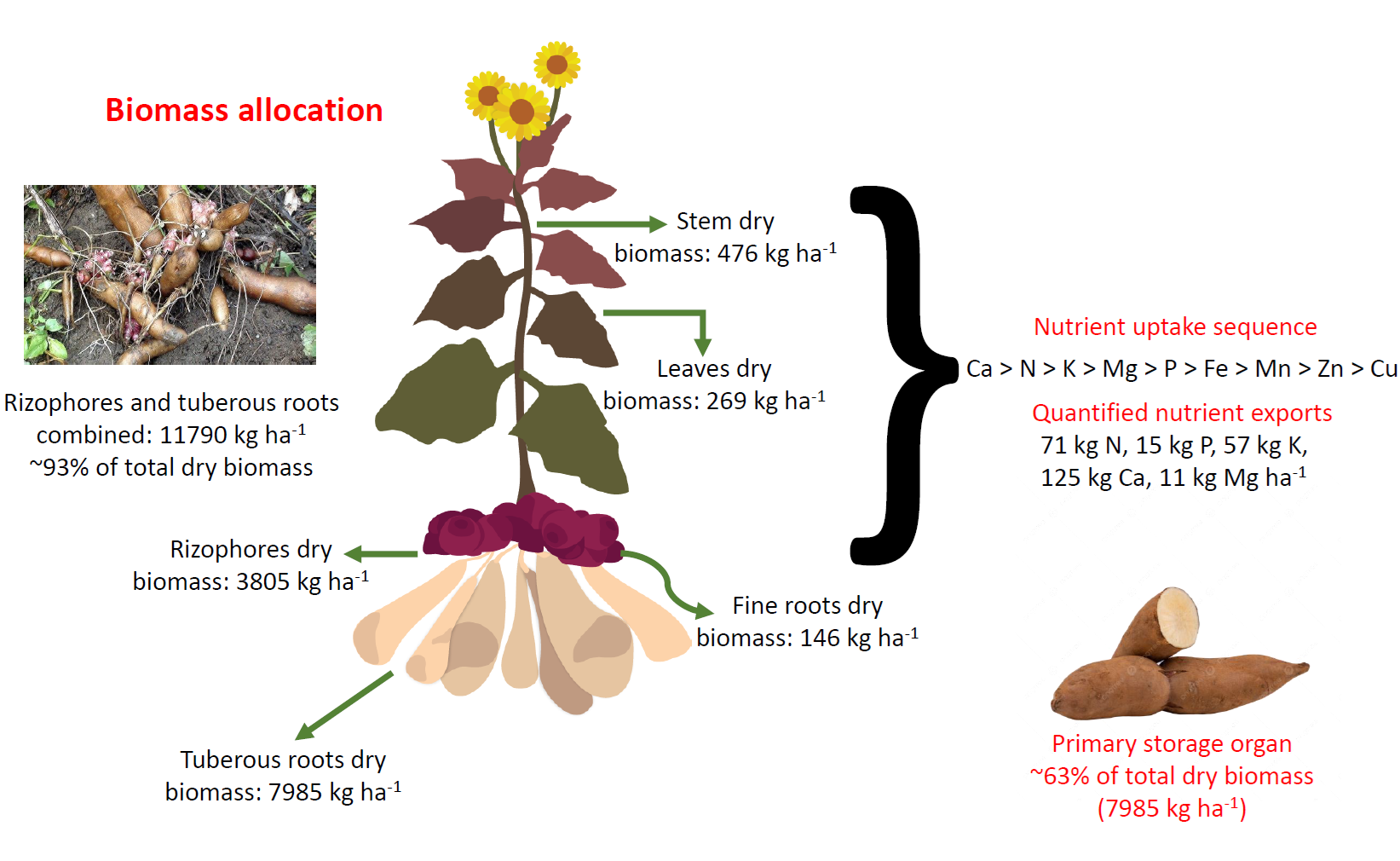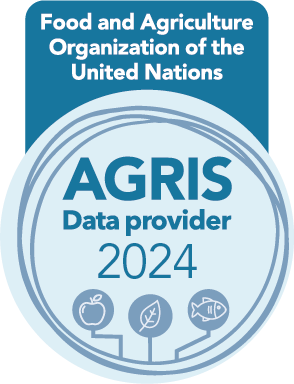Distribution dynamics of nutrient and biomass in yacon organs
DOI:
https://doi.org/10.17268/sci.agropecu.2026.0007Palavras-chave:
Smallanthus sonchifolius, biomass accumulation, nutrient export, nutrient absorption, plant physiologyResumo
Studies on nutrient absorption patterns allow for the identification of periods of peak nutritional demand, the amount of nutrients accumulated in each organ, the quantity exported by harvest, and the necessary replenishment to the soil. These insights are crucial for developing effective fertilization programs for crops. This study aimed to determine the nutrient absorption pattern of macro and micronutrients and the accumulation of biomass in various organs of yacon plants. The experiment was conducted under field conditions, following a randomized block design. The treatments consisted of different plant ages. Seven evaluations were conducted monthly, starting 30 days after transplanting. Twelve plants from the useful area were sampled for each evaluation. The plants were divided into five parts (leaves, stems, rhizophores, roots, and tuberous roots) to determine dry biomass. The samples were analyzed for N, P, K, Ca, Mg, Cu, Fe, Mn, and Zn content. Yacon prioritized the allocation of photoassimilates for biomass production in the following order: tuberous roots, rhizophores, leaves, stems, and fine roots. Nutrient absorption by yacon plants followed this order: Ca > N > K > Mg > P > Fe > Mn > Zn > Cu. Tuberous roots were the main organ for nutrient accumulated, exporting from the system 71, 15, 57, 125, 11, 1.8, 0.87, 0.40, and 0.27 kg há-1 of N, P, K, Ca, Mg, Fe, Zn, Mn, and Cu, respectively. These results provide critical physiological parameters for formulating evidence-based fertilization programs and modeling yacon growth, thereby advancing precision nutrient management. Moreover, integrating these data into agronomic models and sustainability assessments will facilitate the crop’s development as a high-value functional food, supporting both productive and environmental goals.
Referências
Amissah, S., Ankomah, G., Lee, R. D., Perry, C. D., Washington, B. J., et al. (2024). Assessing corn recovery from early season nutrient stress under different soil moisture regimes. Frontiers in Plant Science, 1344022. https://doi.org/10.3389/fpls.2024.1344022
Baligar, V. C., Fageria, N. K., & He, Z. L. (2001). Nutrient use efficiency in plants. Communications in soil science and plant analysis, 32(7-8), 921-950. https://doi.org/10.1081/CSS-100104098
Brandão, C. C., Asquieri, E. R., Attaran, S., & Damiani, C., (2014). Study of the aging of fermented of yacon (Smallanthus sonchifolius) and sensory profile and acceptance. Food Science and Technology, 34, 324-331. https://doi.org/10.1590/S0101-20612014005000032
Carmo, C. A. F. S., Araújo, W. S. A., Bernardi, A. C. C., & Saldanha, M. F. C. (2000). Métodos de análise de tecidos vegetais utilizados na Embrapa Solos. Rio de Janeiro, Embrapa Solos, 2000.
Echer, F. R., Dominato, J. C., & Creste, J. E. (2009). Absorção de nutrientes e distribuição da massa fresca e seca entre órgãos de batata-doce. Horticultura brasileira, 27, 176-182. https://doi.org/10.1590/S0102-05362009000200010
Furlani, A. M. C., Furlani, P. R., Bataglia, O. C., Hiroce, R., Gallo, J. R., et al. (1978). Composição mineral de diversas hortaliças. Bragantia, 37, 33-44. https://doi.org/10.1590/S0006-87051978000100005
Gusso, A. P., Mattanna, P., & Richards, N. (2014). Yacon: benefícios à saúde e aplicações tecnológicas. Ciência rural, 45(05), 912-919. https://doi.org/10.1590/0103-8478cr20140963
Kruger, F. G. Q. (2003). Adubação mineral, orgânica e biodinâmica de yacon (Polymnia sonchifolia Poep & Endl): rendimento, qualidade e armazenamento. https://hdl.handle.net/11449/103265
Li, J., Wu, X., Lu, X., Hou, D., Liu, H., Wang, Y., & Wu, L. (2024). Study on the Changes in the Microbial Community in Rhizosphere Soil of Blueberry Plants at Different Growth Stages. Agronomy, 10, 2393. https://doi.org/10.3390/agronomy14102393
Lyra, D. H., Ribeiro, G. H. M. R., Figueiredo, I. C. R. D., Guedes, M. L., Carneiro, O. L. G., Pinto, C. A. B. P., & Pereira, A. D. S. (2015). Início da tuberização, duração do ciclo vegetativo e tolerância ao calor em genótipos de batata. Pesquisa agropecuária brasileira, 50, 582-592. https://doi.org/10.1590/S0100-204X2015000700008
Ma, Y., Cai, J., Bie, S., Che, Z., Jiang, G., & Liu, J. (2025). Mild drought conditions at the tillering stage promote dry matter accumulation and increase grain weight in drip-irrigated spring wheat (Triticum aestivum L.). Frontiers in Plant Science, 1509325. https://doi.org/10.3389/fpls.2024.1509325
Malavolta, E. (2006). Manual de nutrição mineral de plantas. Agronômica Ceres.
Mao, Y., Xu, Y., Wang, X., Luo, M., Yu, Z., et al. (2024). Study on dry matter accumulation and nutrient absorption and distribution of nitrogen, phosphorus and potassium in cigar eggplant core. Acta Agriculturae Universitatis Jiangxiensis, 6, 1410-1418. https://doi.org/10.3724/aauj.2024122
Marschner, H. (2012). Mineral nutrition of higher plants (3rd ed.). Academic Press. https://doi.org/10.1016/B978-0-12-384905-2.00003-0
Mendes, R. M. D. A., Caetano, G. R., Arpini, C. M., Denadai, J. F., Curbani, F., Gomes, D. C. D. O., & Tadokoro, C. E. (2024). A story with two versions: yacon root pulp on experimental asthma in different animal facilities. Ciência Rural, 54(9), e20230065. https://doi.org/10.1590/0103-8478cr20230065
Moura, N. A., Caetano, B. F., Sivieri, K., Urbano, L. H., Cabello, C., Rodrigues, M. A., & Barbisan, L. F. (2012). Protective effects of yacon (Smallanthus sonchifolius) intake on experimental colon carcinogenesis. Food and chemical toxicology, 50(8), 2902-2910. https://doi.org/10.1016/j.fct.2012.05.006
Pedrosa, J. L. F., de Oliveira, F. L., Zucoloto, M., das Graças Teixeira, A., do Carmo Parajara, M., & Tomaz, M. A. (2020). Yacon (Smallanthus sonchifolius), propagation from rhizophores with different numbers of buds. Revista De La Facultad De Ciencias Agrarias UNCuyo, 52(2), 52-63.
Pezzopane, J. E. M., Castro, F. D. S., Pezzopane, J. R. M., & Cecílio, R. A. (2012). Agrometeorologia: aplicações para o Espírito Santo. Alegre, ES: CAUFES, 174.
Prado, R. M., & Nascimento, V. M. (2003). Manejo da adubação do cafeeiro no Brasil. Ilha Solteira, UNESP/FEIS.
Quaresma, M. A. L., de Oliveira, F. L., Rocha, L. F., Teixeira, A. D. G., da Silva, D. M. N., Dalvi, L. P., & Tomaz, M. A., (2021). Planting recommendations for yacon (Smallanthus sonchifolius) in lowland conditions. Australian Journal of Crop Science, 15, 564-569. https://doi.org/10.21475/ajcs.21.15.04.p2873
R Core Team, (2020). RA language and environment for statistical computing, R Foundation for Statistical. Computing. Disponível em: https://www.R-project.org/
Sacramento, M. D. S., Silva, P. S. R. C., & Tavares, M. I. B. (2017). Batata yacon-alimento funcional. Revista Semioses, 11(03). https://doi.org/10.15202/1981996x.2017v11n3p43
Santos, H. G., Jacomine, P. K. T., Dos Anjos, L. H. C., De Oliveira, V. A., Lumbreras, J. F., et al. (2018). Sistema brasileiro de classificação de solos. Brasília, DF: Embrapa, 2018. http://www.infoteca.cnptia.embrapa.br/infoteca/handle/doc/1094003
Vaz-Tostes, M. G., Viana, M. L., Grancieri, M., dos Santos Luz, T. C., de Paula, H., Pedrosa, R. G., & Costa, N. M. B. (2014). Yacon effects in immune response and nutritional status of iron and zinc in preschool children. Nutrition, 30(6), 666-672. https://doi.org/10.1016/j.nut.2013.10.016
Verediano, T. A., Viana, M. L., das Graças Vaz Tostes, M., de Oliveira, D. S., de Carvalho Nunes, L., & Costa, N. M. (2020). Yacón (Smallanthus sonchifolius) prevented inflammation, oxidative stress, and intestinal alterations in an animal model of colorectal carcinogenesis. Journal of the Science of Food and Agriculture, 100(15), 5442-5449. https://doi.org/10.1002/jsfa.10595.

Downloads
Publicado
Como Citar
Edição
Seção
Licença
Copyright (c) 2025 Scientia Agropecuaria

Este trabalho está licenciado sob uma licença Creative Commons Attribution-NonCommercial 4.0 International License.
Los autores que publican en esta revista aceptan los siguientes términos:
a. Los autores conservan los derechos de autor y conceden a la revista el derecho publicación, simultáneamente licenciada bajo una licencia de Creative Commons que permite a otros compartir el trabajo, pero citando la publicación inicial en esta revista.
b. Los autores pueden celebrar acuerdos contractuales adicionales separados para la distribución no exclusiva de la versión publicada de la obra de la revista (por ejemplo, publicarla en un repositorio institucional o publicarla en un libro), pero citando la publicación inicial en esta revista.
c. Se permite y anima a los autores a publicar su trabajo en línea (por ejemplo, en repositorios institucionales o en su sitio web) antes y durante el proceso de presentación, ya que puede conducir a intercambios productivos, así como una mayor citación del trabajo publicado (ver efecto del acceso abierto).




